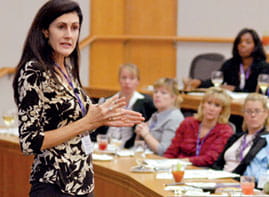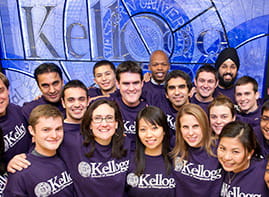New research by Associate Professor Katherine Phillips suggests that adding a newcomer can increase a group’s discomfort — and improve the quality of its results
4/7/2009 - Nobody wants to share a cubicle with a new hire like Dwight Schrute, the unsettling paper salesman from NBC's "The Office."
But according to new research by a professor from the Kellogg School of Management, better decisions come from teams that include a "socially distinct newcomer." That's psychology-speak for someone who is different enough to bump other team members out of their comfort zones.
“This paper shows that it’s not solely about the newcomer bringing a new idea, but their mere presence changes the behavior of the group. This is one example of the benefits of diversity,” said lead author Katherine Phillips, associate professor of management and organizations at the Kellogg School. “Diversity goes beyond newcomers bringing new ideas.”
Researchers noticed this effect after conducting a traditional group problem-solving experiment. The twist was that a newcomer was added to each group about five minutes into their deliberations. And when the newcomer was a social outsider, teams were more likely to solve the problem successfully.
The key factor is simply whether newcomers are distinct in some way from the other group members.
The research is published in the March 2009 issue of
Personality and Social Psychology Bulletin with co-authors Katie Liljenquist of Brigham Young University’s Marriott School of Management and Margaret Neale of Stanford Graduate School of Business.
What explains the results? According to Phillips, newcomers in the experiment did not necessarily ask tougher questions, possess novel information, or doggedly maintain a conflicting point of view. Just being there was enough to change the dynamic among old-timers who shared a common identity.
When a member of the group discovered that he agreed with the new outsider, he felt alienated from his fellow old-timers — consequently, he was very motivated to explain his point of view on its merits so that his peers would not lump him in with the outsider. An opinion alliance with an outsider put his social ties with other team members at risk.
Even more important was the response of the rest of the group – everybody in the groups where the newcomer was a social outsider worked hard to solve the problem and resolve the social discomfort.
Another revelation The experiment also revealed a fallacy in the assumptions we make about our own effectiveness in groups. The subjects in the experiment were members of different fraternities and sororities. In general, when the newcomer was from the same sorority or fraternity as the other team members, the group reported that it worked well together, but was less likely to correctly solve the problem.
In contrast, when the newcomer was a member of a rival sorority or fraternity, the opposite was true — these groups felt they worked together less effectively, yet they significantly outperformed socially homogenous groups.
“Oftentimes when people think of the effects of diversity, they focus on the one or two people in the minority, instead of thinking about how the diversity impacts the majority of the group,” Phillips says. “In diverse groups, everyone is more likely to focus on the available information and to bring in new ideas, not just the people who are ‘different’.”
In the workplace
Common "social distinctions" in today's workplace that include but go beyond the typical demographic differences we traditionally think about (e.g., race and gender), Phillips says, would include:
- One employee from accounting working on a team in which everyone else is from sales
- An employee of a company that has just been bought out finding herself on a team of people from the acquiring firm
- An out-of-stater finding himself on a team full of natives of the company's home state
Socially distinct newcomers like Dwight Schrute may create some discomfort, says Phillips. To help employees in those situations cope, managers would be wise to explain that such conflict can actually generate better results. Her research shows that these “managerial” assets are valuable to a company’s bottom line—especially during an economic downturn.
“Many organizations are trying to figure out what is the value of diversity,” says Phillips. “I think it will be very hasty for organizations to set aside or get rid of their diversity efforts. Creating a diverse and inclusive workplace affects everybody in the organization, even if they don’t look ‘diverse’ on the surface. Dropping those diversity efforts may put the company at risk of losing their competitive edge.”






